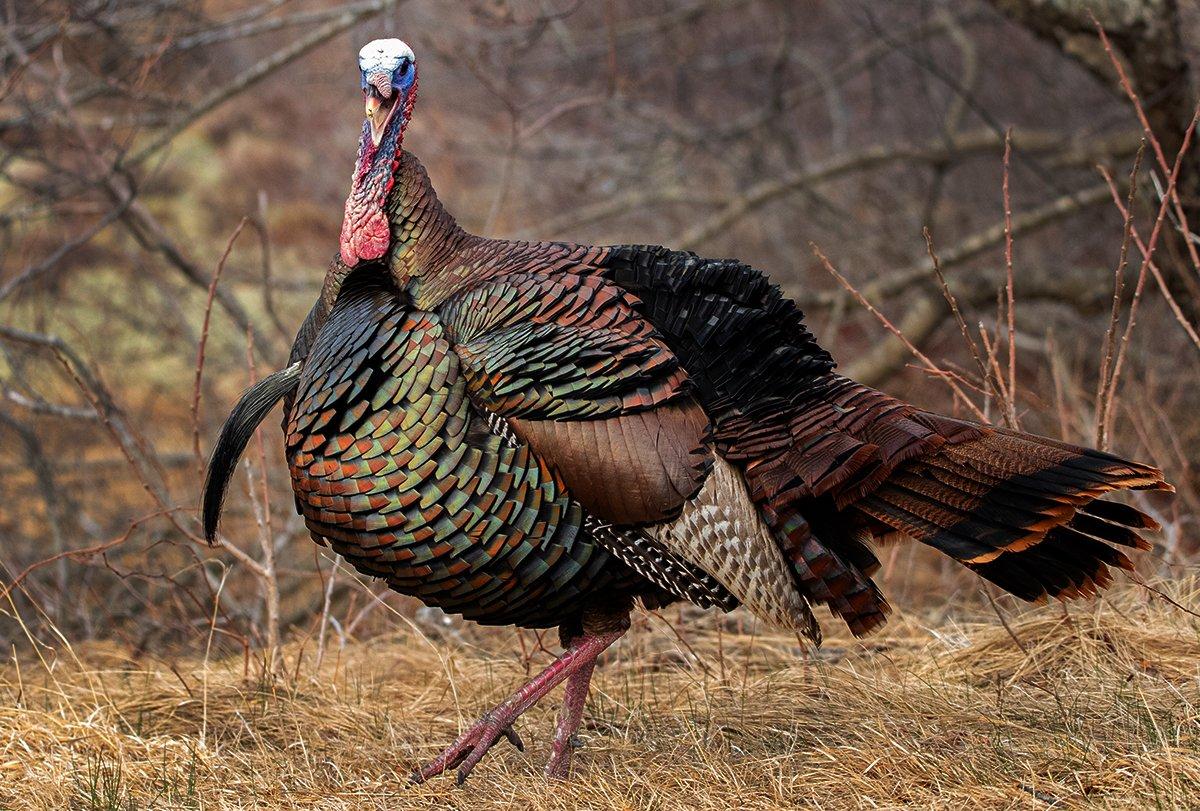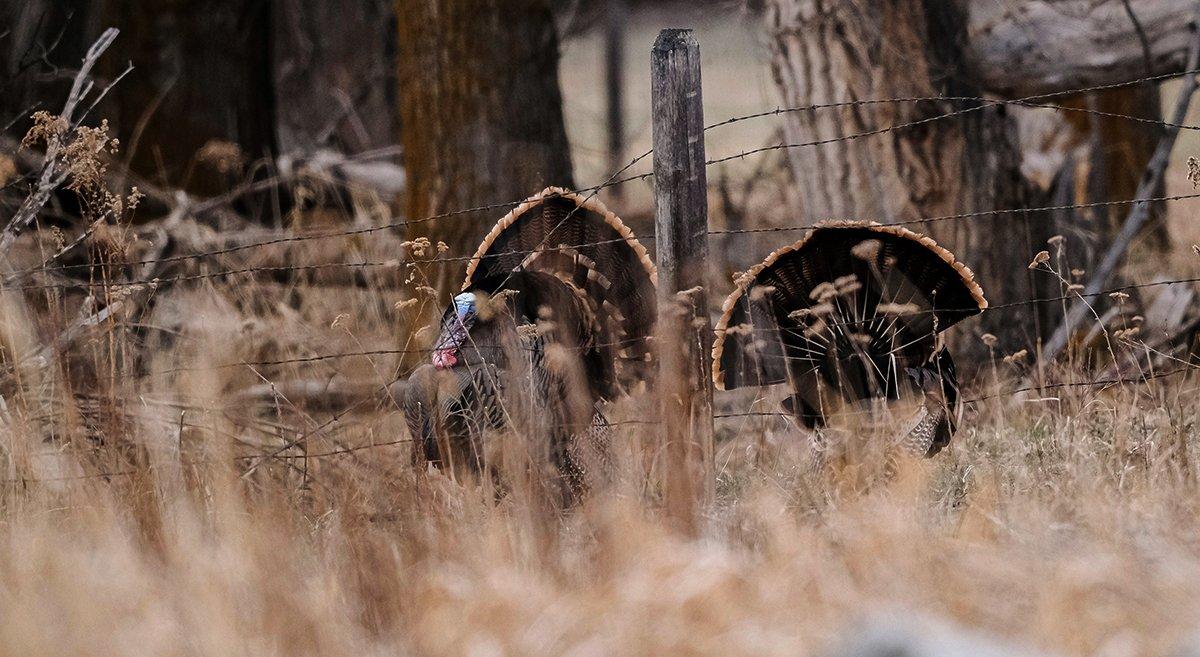You worked hard to get that gobbler into range. Don't mess it up by rushing a bad decision
How do we still miss turkeys? People knock down tiny doves flying 60 miles per hour, usually with cheap target ammo and plain old shotguns. Turkey hunting guns, meanwhile, are routinely decked out with optics and custom choke tubes, and plenty of hunters use $15 shells (that's $15 per shot). This is in an effort to hit a stationary target roughly the size of a wine bottle from a seated, rested position.
And still, we miss. Three times in a row, on occasion — $45 worth of hard-to-find tungsten scattered across the spring woods with nothing to show for it but the memory of a giant gobbler flying away unscathed. It's agonizing, and worse than missing a big buck if you ask me. In fact, the only thing in hunting that's harder on your soul than missing a turkey is wounding and losing one, something that probably happens on more of those clean misses than we realize.
But it happens to us all. I've been turkey hunting almost 30 years myself, and I still wrestle with demons from misses past (including two last spring). But that school of hard knocks has taught me some things, too, including that when I do whiff on a turkey — or watch someone else miss one, which isn't nearly as bad — one of these things is usually to blame.
A Hill and a Surprise
I learned to hunt turkeys in the white oak woods without decoys, gaming the terrain to stay hidden from the turkey's view until I'd called him to within gun range. It's still my favorite way to turkey hunt, but it can also present some tricky shooting because turkeys frequently appear in places where you don't expect them.
Last spring, after a 3-hour game of cat and mouse in the hills of Tennessee, the gobbler I was working finally came strutting down the spine of the ridge to my setup. Instead of continuing his course, which would've put him in front of my gun in a beautiful 30-yard shooting lane, he went over the ridge, flanked my setup to the left, and then craned his ugly head into view at about 8 yards. I had managed to twist into position for a shot, but I missed him clean nonetheless.
The Fix: Never sitting closer than 20 yards to the break of a hill will solve many of these problems. Sometimes that can't be avoided, though, and you need to plant yourself in a hurry. When it looks as though the gobbler is going to flank you, be aggressive about moving into shooting position, but then slow down and aim deliberately when the shot opportunity materializes.
(Don't Miss: Where do Winter Turkey Flocks Go?)
You Shot a Tree
I missed that hill turkey last spring because I got in a hurry about shooting him. Due to that haste, I didn't notice the sapling tree in front of my gun barrel that blew my pattern before it ever got to the bird (it had barely cleared the muzzle, actually). That error goes hand-in-hand with turkeys popping up over blind hills and snapping yourself into a new position.
The Fix: Tunnel vision and a rushed shot opportunity combine to cause stupid mistakes. Slow down and look at what's between you and the turkey before you shoot.
You Tried to Shoot Through Brush
The turkey is at 25 yards, gobbling like crazy but standing behind a deadfall. You can see his head just fine through those limbs, he's plenty close, and you're shooting TSS and a fancy choke tube — he's good as dead, right? Send it!
No. I've seen more gobblers wounded, including most of the turkeys I've wounded myself, because of forced shots through cover. You're not threading a rifle bullet. It takes little more than a blade of grass to derail a pellet's flight path, and so your pattern, after it goes through that brush, will be full of gaps, some of which are big enough to go right around a turkey's head. Other pellets might hit the bird, but who knows where.
The Fix: The aggravating truth of a turkey hung up behind a brush pile is that they frequently stay there, and then turn and walk straight away. Wait for an open shot but, if you don't get it, don't panic. Let the gobbler drift out of sight, keep quiet for 15 minutes, and then slip ahead, past that brush pile (maybe even against it), and call him back in.
You Didn't Fear the Reaper
Yes, I know some believe reaping and fanning represent all that's wrong with modern turkey hunters. Some states have even outlawed it. But let's pretend, if only for a moment, that some legal hunter, somewhere, will try to reap a turkey this spring, and that they're mostly a person of good character, and that they enjoy turkey hunting just as much as you do, and that they don't believe the practice will condemn them to eternal damnation. A dead turkey is a dead turkey and, besides, it's not like they're shooting them with rifles.
A dead turkey is a dead turkey and, besides, it's not like they're shooting them with rifles.
All that said, the simple reality is you're likelier to miss a turkey while reaping than while sitting against a tree and calling. This is partly because you're crawling across the ground, all out of position, and also because you have to deal with a decoy that's in one hand and a shotgun in the other. You could perhaps be worried about a charging gobbler piercing your upper ear with a spur, too.
The Fix: Calm down. The worst thing you can do is drop the decoy and attempt to quick draw an alarmed gobbler at the end of an all-but-successful reap. What's going to happen if you try that is? You'll miss three times. If it's on video, the display is enough to cause your turkey hunting elders to choke on their wing-bone calls and demand legislative action.
Instead, stake the decoy firmly into the ground as the turkey is approaching, sit on your butt, shoulder your gun, and press your cheek good and firm against the stock. Then lean out slowly behind the fan, aim carefully, and shoot him right in the wattles. Gobblers coming to a strutter decoy are amped up and expecting movement, and even if they get squirrelly, you'll probably have plenty of time to shoot after they drop strut to give you the side-eye.
(Don't Miss: The Best Semi-Guided Turkey Hunts)
You Brought a Little Gun
TSS shotgun shells have made sub-gauge shotguns into legitimate turkey killers, so much so that hunting with a .410 is now worthy of bragging rights. My 8-year-old son hunts with a CVA Scout .410 loaded with Federal Premium TSS No. 9s. It's a great little setup, especially for a young hunter, and he's killed four turkeys with it to date. But when he gets bigger, I'll encourage him to switch to a bigger gun.
Meanwhile, I've taken to hunting with a 20-gauge often as not. It's a lightweight Benelli M2 that's a joy to carry, and it throws a tight pattern that'll kill gobblers to as far as I want to shoot at them (50 yards and in for me).
But there is a hard truth to face: I miss more turkeys with the 20 than I do with a 12. Though the .410 works very well, it's still a .410, and that means that it has limitations.
The Fix: Little guns are just that. Sure, they have their perks like less recoil and weight. But if a little shell filled with TSS is good, a big shell filled with more of it is better. With a shotgun, when shooting at a turkey's head, there is no such thing as overkill. Shooting a turkey with a sub-gauge doesn't prove that you're a superior hunter.
You Shot from Too Far
Here's the one you came for. Yes, there are gross examples on video of people shooting at turkeys from too far away, and then bragging about the shot distance. Critics even suggest that TSS shot is to blame — that it's causing too many otherwise reasonable people to shoot at turkeys from unreasonable distances, and therefore should be outlawed along with dried fans and ground blinds and whatever else is on the Turkey Temperance List these days.
That's crazy talk. The real advantage of TSS is in the near sure thing it provides inside 50 yards, not in extreme-range capability. Yeah, there are some bad examples out there, but you can find bad examples of all sorts of things on the internet, if you go to looking. (Free Tip: Do that at home, not at work.) I personally don't know any turkey hunters who set out to take long shots. Most of those long shots — including the few I've taken myself — have happened because of errors in range estimation and not intent.
The Fix: This one is easy. Carry a rangefinder. Lightweight models that'll fit in a shirt pocket abound and sell for cheap. In fact, the first thing I try to do at every setup is range a few landmarks, be they trees in the woods or cow pies in a pasture. When I know for a fact that a gobbler is beyond 50 yards, I just don't shoot.
(Don't Miss: 6 Tips for Public-Land Turkey Hunting)
Final Takeaway
Most of these fixes have a common thread of slowing down and being more deliberate. Keeping a cool head to do that comes with experience. Select your setup a little more carefully. Take an extra second to aim. Turkey hunting is fun because of the in-your-face action it can provide, but that perceived pressure can lead to rushed decision making. You almost always have more time than you think to shoot a gobbler — and if things aren't right, you have a better chance of getting him by just letting him walk away and then repositioning than by taking a wild shot and wounding him.
Maybe this spring, which will be No. 29 for me, I'll remember all of my own advice.











